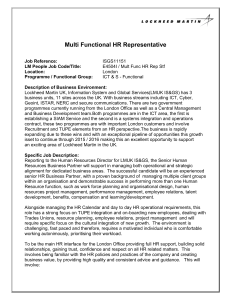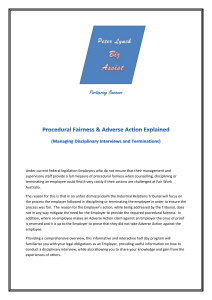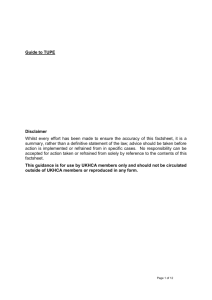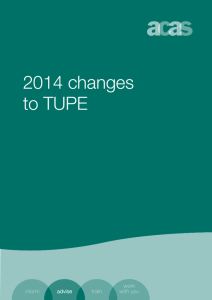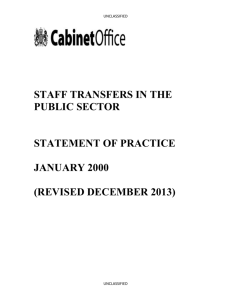CAR_LIB1\6876925\1
advertisement
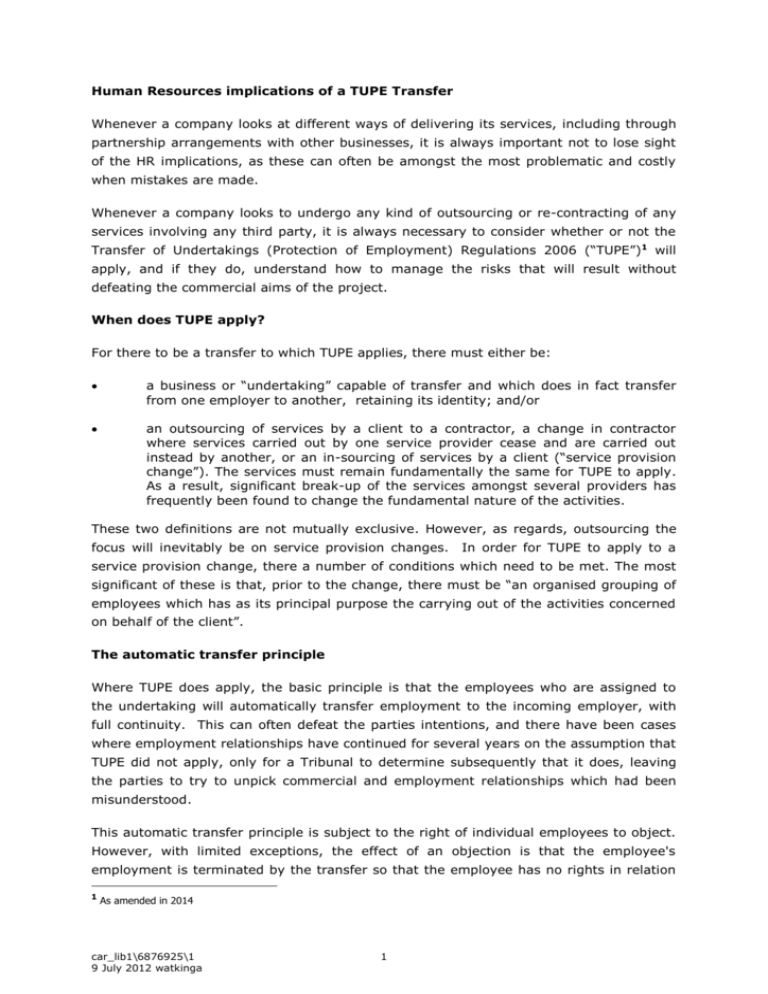
Human Resources implications of a TUPE Transfer Whenever a company looks at different ways of delivering its services, including through partnership arrangements with other businesses, it is always important not to lose sight of the HR implications, as these can often be amongst the most problematic and costly when mistakes are made. Whenever a company looks to undergo any kind of outsourcing or re-contracting of any services involving any third party, it is always necessary to consider whether or not the Transfer of Undertakings (Protection of Employment) Regulations 2006 (“TUPE”) 1 will apply, and if they do, understand how to manage the risks that will result without defeating the commercial aims of the project. When does TUPE apply? For there to be a transfer to which TUPE applies, there must either be: a business or “undertaking” capable of transfer and which does in fact transfer from one employer to another, retaining its identity; and/or an outsourcing of services by a client to a contractor, a change in contractor where services carried out by one service provider cease and are carried out instead by another, or an in-sourcing of services by a client (“service provision change”). The services must remain fundamentally the same for TUPE to apply. As a result, significant break-up of the services amongst several providers has frequently been found to change the fundamental nature of the activities. These two definitions are not mutually exclusive. However, as regards, outsourcing the focus will inevitably be on service provision changes. In order for TUPE to apply to a service provision change, there a number of conditions which need to be met. The most significant of these is that, prior to the change, there must be “an organised grouping of employees which has as its principal purpose the carrying out of the activities concerned on behalf of the client”. The automatic transfer principle Where TUPE does apply, the basic principle is that the employees who are assigned to the undertaking will automatically transfer employment to the incoming employer, with full continuity. This can often defeat the parties intentions, and there have been cases where employment relationships have continued for several years on the assumption that TUPE did not apply, only for a Tribunal to determine subsequently that it does, leaving the parties to try to unpick commercial and employment relationships which had been misunderstood. This automatic transfer principle is subject to the right of individual employees to object. However, with limited exceptions, the effect of an objection is that the employee's employment is terminated by the transfer so that the employee has no rights in relation 1 As amended in 2014 car_lib1\6876925\1 9 July 2012 watkinga 1 to that termination of employment against either of the employers. For example, there is no right to claim unfair dismissal or redundancy pay. In addition to the transfer of the contract of employment, most pre-transfer liabilities relating to the employees will also transfer to the new employer, provided the old employer is not insolvent. This will include, for example, arrears of wages and statutory rights and liabilities e.g. claims for equal pay and sex discrimination. In addition, any of these liabilities which relate to any employee who is dismissed prior to the transfer, solely or principally because of the transfer will also transfer in the absence of an ETO reason (see below). Liabilities which will not transfer are those which relate to the majority of rights arising under an occupational pension scheme (see below), criminal liability of the old employer and any liabilities in relation to a former employee whose dismissal was not a result of the transfer (e.g. for misconduct). Information and consultation Both the old and new employers share a duty to inform and potentially to consult with appropriate representatives of employees affected by a proposed transfer. An exception is that, from 1st July 2014, organisations employing 10 or fewer staff and which do not recognise a trade union will be exempt from the requirements to appoint appropriate employee representatives, where there are none already in place. These small employers may satisfy consultation requirements by consulting with the employees directly. Information regarding the transfer must be provided to appropriate employee representatives (such as a recognised trade union), long enough before transfer to allow consultation to take place. If "measures" (for example, changes in terms and conditions, grading or redundancies) are also proposed in relation to affected employees, consultation must also then take place with the representatives. Consultation must commence in good time so as to enable it to be carried out prior to the transfer. TUPE permits a new employer to engage in pre-transfer consultation and for this to count towards the legal obligations to collectively consult, even though they are not strictly “the employer”. There are, however, conditions attached: the new employer must give the old employer written notice that it intends to engage in pre-transfer consultation and the old employer must agree in writing (and may also withdraw this consent at any time). If either employer fails to inform and consult, the representatives may present a complaint to an Employment Tribunal within three months of the completion of the transfer. Both the new and old employers are jointly and severally liable for this failure so that a claim may be brought against either or both. If a complaint is upheld, the Employment Tribunal can order that compensation be paid to affected employees. If a trade union is recognised, the employer must inform/consult with the union. car_lib1\6876925\1 9 July 2012 watkinga 2 Any agreement to contract out of TUPE is void although there is authority to suggest it is possible to legitimately compromise an unfair dismissal claim through a settlement agreement or through ACAS. Carrying out redundancies as part of a restructure One of the important protections which TUPE offers to employees, is that any dismissal which arises solely or principally by reason of the transfer is automatically unfair unless it is for an economic, technical or organisational reason entailing changes in the workforce. This is commonly known as the ETO defence. There is relatively little guidance as to what ETO exactly means but, broadly speaking, it can be compared with a redundancy or restructuring situation. For example, following a transfer where there is duplication of staffing and there consequently needs to be a headcount reduction, that would fall within the ETO defence. The most important aspect of the ETO defence and the one that is most commonly forgotten is the phrase, “entailing changes in the workforce”. This has been found to mean specifically that there must either be a reduction in head count or change to the function or carrying out of a particular job. More recently, the meaning of a change in the workforce has helpfully been extended to include a change in location, enabling a transferee to effect redundancies without breaching TUPE. One further point to note is that the ETO defence will only be available if the dismissals are carried out by the incoming employer following the transfer, where the dismissal relates to the future conduct of the business (i.e. following a transfer there will be duplication of the roles). The intention behind this is to ensure that employees are given the opportunity to apply for any vacancies in the new organisation, however, in practice because this is often carried out prior to the transfer, it can often lead to the situation of de-motivated employees being retained until after the transfer date just to be made redundant. Engaging in pre-transfer consultation can help inform the employees and shorten the period of delay between notional transfer and dismissal. One alternative option, if the intention is to carry out the redundancies prior to the transfer but to avoid the risk, is to look to agree settlement agreements with employees who are to leave. Changing terms and conditions One of the most difficult areas to manage in practice, following a transfer, is the general prohibition on varying terms and conditions of employees where the sole or principal reason for that change is the transfer itself. Identifying when changes are solely or principally by reason of a transfer will depend on the circumstances, although this does allow argument that the reason is unconnected. Harmonisation is prohibited (in the sense of bringing terms of transferring employees in line with existing employees). Change is therefore problematic but not impossible if it fits within one of the following:- car_lib1\6876925\1 9 July 2012 watkinga 3 (i) Reason not connected with the transfer The first and most obvious basis on which changes can be effected, is where the transfer is not the sole or principal reason for the change. This might be because the change was going to happen to the workforce regardless of whether the transfer took place or, more commonly, something occurs following the transfer which causes the need for change. For example, it might be the case that due to a changing economic climate, changes in terms and conditions may need to be made, specifically those relating to pay. A common misconception is that, if sufficient time is allowed to pass following a transfer, then a subsequent change will no longer be solely or principally by reason of it. This is not correct. Whilst the passing of time inevitably increases likelihood of some intervening event which might justify the change for reasons other than transfer, in theory, a change which takes place several years after the transfer can still potentially be void if the reason for it can be linked back directly to the transfer itself. That having been said, in practice, changes are often made following a transfer several months and years later without any real difficultly or litigation on the basis that quite simply the employees often forget about their rights when the transfer becomes a dim and distant memory. (ii) Changes for an ETO reason In addition to the above, it is possible to agree changes to terms and conditions where the changes are for an ETO reason. For this purpose ETO reason has the same meaning as in cases of carrying out a dismissal (see above). In essence in order to be able to fall within an ETO reason you generally need to demonstrate either a change in job function or head count reduction. Although this exemption is actually fairly narrow and designed to cover circumstances where a potential redundancy situation arises, in practice it is often used as a banner under which to harmonise terms and conditions following a transfer. Whilst such a step may, on the face of it, prove attractive, the danger is that such a move would be ineffective, and then when the employer comes to enforce a particular term of the contract some months, or even years, down the line, it finds that actually that change was void. (iii) Reliance upon pre-existing term Since the underlying principle of TUPE is that the new employer effectively ‘steps into the shoes’ of the old employer, the new employer similarly inherits any contractual right of variation retained by the old employer. An example might be a mobility clause, permitting a change in location but others may well apply, enabling a new employer to make changes which do not breach the employee’s contract terms. (iv) Dismissal and re-engagement The third and most effective, although generally least popular, route is to terminate the contracts of the staff upon notice with an offer of re-engagement. This move will prevent employees seeking to argue that any changes to their terms and conditions are void, as if car_lib1\6876925\1 9 July 2012 watkinga 4 they accept they will be employed under a new contract. However, because notice has been served to terminate the contract at law, this counts as a dismissal even if the employee subsequently accepts. Because this is a dismissal which is inevitably by reason of the transfer, unless there is an ETO defence in place (which generally there will not be) then this will render any dismissals automatically unfair, with the employee being entitled to compensation. In addition, this would also potentially trigger the need to carry out collective redundancy consultation and issue a form HR1 to the insolvency service, where there are 20 or more staff affected at a single site. Due to this, unless the changes are essential in practice e.g. the removal or reduction of core commercial terms e.g. pay, bonus or benefits, this approach is rarely adopted. (iv) Terms derived from collective agreement Restrictions upon contractual changes in a transfer context after one year have been lifted for terms derived from collective agreements. Revision of such terms may therefore be agreed but only if what replaces them are no less favourable “when considered together”. The practical effect of this provision may be limited but it nonetheless opens opportunity for discussion over changes to terms which would previously have been prohibited under TUPE. Pensions The starting point with pensions under TUPE is that most rights under an occupational pension scheme do not transfer. The exception to this is that any rights which do not relate to old age, invalidity of survivors benefits, will transfer. The most common example of such a right is any entitlement of an employee under a pension scheme to payments in the event of redundancy. Even where accrued rights under an occupational pension scheme are excluded, new employers need to be aware that they are liable to provide alternative pension provision post-transfer for those transferring employees who had access to a scheme operated by the old employer and will need to match certain pension contributions. For example, employees must be offered post-transfer either: a final salary (defined benefit) occupational pension scheme which meets specified statutory requirements and offers benefits of equivalent value to the contributions made to the scheme (where the transferor’s contribution was at least 6% of pensionable pay and the transferring employee contributed no more than 6% of pensionable pay); or a money purchase (defined contribution) occupational pension scheme or a stakeholder pension arrangement, in which case the employer has a choice as to whether to make a matching contribution to that of the transferring employee (of car_lib1\6876925\1 9 July 2012 watkinga 5 up to 6 per cent of actual gross basic pay) or a matching contribution to that of the old employer. Are there any alternatives to TUPE? One of the fundamental aspects of TUPE is that it is not possible to contract out of its provisions as a matter of law and Employment Tribunals will always scrutinise closely any structures put in place which attempt to defeat TUPE. However, there are a number of alternatives options which, if handled correctly, may overcome some of the difficulties TUPE can create:(i) Secondment and the Retention of Employment model In employment law terms, at its most simple, a secondment is a variation of contract agreed between employer and employee by which changes are made in relation to the employee’s contract, for example in relation to his/her day to day duties, reporting lines, place of work. It is usually of a relatively short duration as it is understood that the longer a secondment continues, particularly if the employer ceases to have effective control over the employee, the easier it is to argue that the employment relationship between the secondee and the employer has come to an end. There is always a risk for the organisation to which the individual is seconded that he/she may at some point allege and/or be held by a Court or Employment Tribunal to be an employee of the recipient organisation. Case law shows that an Employment Tribunal is happy to look behind the labels which the parties have put on a relationship and conclude that the legal reality is that the employment relationship has shifted from one organisation to another. As it has become increasingly common within the public sector in particular to outsource services to the private sector, there has been an increase in the use of secondments, often as a means of ensuring that staff can remain in a public sector pension scheme which private sector providers cannot afford to match, or on occasion as a means of avoiding the transfer of public sector staff into the private sector which is seen as politically unacceptable in some quarters. Secondment has been applied in the most clearly structured way in relation to PFI schemes in the NHS where the Retention of Employment Model (“REM”) has been adopted. In such projects REM has to be applied to certain categories of staff - those engaged in cleaning, catering, laundry, security and portering. Although TUPE applies in such situations and all staff would be expected to transfer, REM provides for management staff transfer to the private sector provider whilst operational staff are retained in NHS employment and seconded to the private sector provider in order to undertake the necessary work. The legal process by which this is effected is for the operational staff to be given the opportunity to formally object to being transferred (see above) to the private sector car_lib1\6876925\1 9 July 2012 watkinga 6 provider on the basis that they will be retained (rather than regarded as having resigned) and then seconded as described above. A variation on the REM theme is the Choices Model where staff are given the option of transferring to the new provider at the start of the contract, or at any time during the life of the contract. This has proved of particular interest in Local Authority Strategic Partnerships in relation to IT services where staff who are initially cautious about the idea of leaving Local Authority employment, subsequently become more confident about employment with the private sector provider and see the benefits of greater career progression/training following a transfer. Employment lawyers have always urged caution in relation to long term secondments because of the risk (outlined above) that these may subsequently be regarded as a TUPE avoidance device and therefore void. A case on point was Celtec v Astley where, after a referral to the European Court of Justice, the House of Lords held that a “secondment” of staff from the Department of Education to Training & Enterprise Councils in 1990 had been void because on an analysis of the law, a TUPE transfer had taken place at that time. This was so despite the employees and employer believing otherwise. In other words, an arrangement which the transferor and transferee employers had put in place and which the employees had accepted, had not been effective. Similarly, in Capita Health Solutions v BBC and McLean where an employee objected to the transfer of her employment and then entered into a short term secondment arrangement to the transferee to perform a handover. In that case the EAT upheld a finding that her objection was ineffective, and as a consequence her employment had transferred to the transferee. These decisions, call into serious doubt the effectiveness of the REM model. However, in practice, such arrangements continue to be put in place, on the basis that they are popular will employers, employees and private sector partners. If this approach is to be adopted then it will be necessary to ensure that there is full consultation with staff and their representatives on the issue so that individuals are aware of all the options open to them and choose freely whether or not to object to a transfer of employment in order to enable a secondment to take place. Furthermore, careful consideration should be given to the use of indemnities in relation to any agreement of this type between the public sector body and the host organisation where long term secondments are in place, to ensure the risk is shared out as the parties intended. (ii) Shattering the contract A practice which has become increasingly common since the 2006 TUPE regulations extended the application of TUPE to re-contracting arrangements, is to look to award the contract to a number of providers, so that ideally no employee can point to a single provider who has taken over the majority of their responsibilities. shattering the contract. car_lib1\6876925\1 9 July 2012 watkinga 7 This is known as Whilst care needs to be taken to ensure that what is not created is simply several TUPE transfers rather than just one, this approach has been endorsed by the Tribunals in numerous cases including Thomas-James and others v Cornwall County Council and others, where the Council was originally one of 17 organisations contracted with the Legal Services Commission to provide a free legal helpline across the country. Following a retender 9 organisations were appointed, on a totally different geographic basis, such that it was not possible for the claimants to identify a single company who had taken responsibility for their work, and so it was found there was no transfer. January 2012 Please note this is a very brief overview of a very complicated piece of legislation and not a complete account of the law. In addition, there are many aspects of TUPE where the law is ambiguous and the outcome of tribunal cases is unpredictable. In consequence the best advice often has to proceed on the basis that this uncertainty exists and any action should be planned with that in mind. car_lib1\6876925\1 9 July 2012 watkinga 8
